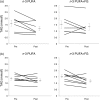Dietary supplementation with fish gelatine modifies nutrient intake and leads to sex-dependent responses in TAG and C-reactive protein levels of insulin-resistant subjects
- PMID: 25191544
- PMCID: PMC4153331
- DOI: 10.1017/jns.2012.13
Dietary supplementation with fish gelatine modifies nutrient intake and leads to sex-dependent responses in TAG and C-reactive protein levels of insulin-resistant subjects
Abstract
Previous studies have shown that fish protein, as well as marine n-3 PUFA, may have beneficial effects on cardiovascular risk profile. The objectives of this study were to investigate the combined effects of fish gelatine (FG) and n-3 PUFA supplementation on (1) energy intake and body weight, (2) lipid profile and (3) inflammatory and CVD markers in free-living insulin-resistant males and females. Subjects were asked to consume, in a crossover study design with two experimental periods of 8 weeks each, an n-3 PUFA supplement and n-3 PUFA supplement plus FG (n-3 PUFA + FG). n-3 PUFA + FG led to an increase in protein intake and a decrease in carbohydrate intake compared with n-3 PUFA (P < 0·02) in males and females. Sex-treatment interactions were observed for TAG (P = 0·03) and highly sensitive C-reactive protein (hsCRP) (P = 0·001) levels. In females, n-3 PUFA reduced plasma TAG by 8 % and n-3 PUFA + FG by 23 %, whereas in males, n-3 PUFA reduced plasma TAG by 25 % and n-3 PUFA + FG by 11 %. n-3 PUFA increased serum hsCRP by 13 % and n-3 PUFA + FG strongly reduced hsCRP by 40 % in males, whereas in females, n-3 PUFA reduced serum hsCRP by 6 % and n-3 PUFA + FG increased hsCRP by 20 %. In conclusion, supplementation with FG may enhance the lipid-lowering effect of marine n-3 PUFA in females and beneficially counteract the effect of n-3 PUFA on serum hsCRP in males. Further studies are needed to identify the sex-dependent mechanisms responsible for the divergent effects of FG on TAG and hsCRP levels in females and males, respectively.
Keywords: CVD; FG, fish gelatine; Fish gelatine; Inflammatory markers; TAG; hsCRP, highly sensitive C-reactive protein; n-3 Fatty acids.
Figures


Similar articles
-
Diets enriched in menhaden fish oil, seal oil, or shark liver oil have distinct effects on the lipid and fatty-acid composition of guinea pig heart.Mol Cell Biochem. 1997 Dec;177(1-2):257-69. doi: 10.1023/a:1006871524271. Mol Cell Biochem. 1997. PMID: 9450671
-
Effects of a supplementation of n-3 polyunsaturated fatty acids with or without fish gelatin on gene expression in peripheral blood mononuclear cells in obese, insulin-resistant subjects.J Nutrigenet Nutrigenomics. 2011;4(4):192-202. doi: 10.1159/000330226. Epub 2011 Aug 26. J Nutrigenet Nutrigenomics. 2011. PMID: 21876360 Clinical Trial.
-
Dietary inclusion of salmon, herring and pompano as oily fish reduces CVD risk markers in dyslipidaemic middle-aged and elderly Chinese women.Br J Nutr. 2012 Oct 28;108(8):1455-65. doi: 10.1017/S0007114511006866. Epub 2012 Jan 6. Br J Nutr. 2012. PMID: 22221492 Clinical Trial.
-
Effects of age, sex, body mass index and APOE genotype on cardiovascular biomarker response to an n-3 polyunsaturated fatty acid supplementation.J Nutrigenet Nutrigenomics. 2013;6(2):73-82. doi: 10.1159/000350744. Epub 2013 May 8. J Nutrigenet Nutrigenomics. 2013. PMID: 23689286 Review.
-
n-3 fatty acids and the risk of sudden cardiac death. Emphasis on heart rate variability.Dan Med Bull. 2003 Nov;50(4):347-67. Dan Med Bull. 2003. PMID: 14694851 Review.
References
-
- Harris WS, Michael M, Ann PT, et al. (2008) Omega-3 fatty acids and coronary heart disease risk: clinical and mechanistic perspectives. Atherosclerosis 197, 12–24 - PubMed
-
- Calder PC (2006) n-3 Polyunsaturated fatty acids, inflammation, and inflammatory diseases. Am J Clin Nutr 83, 1505S–1519S - PubMed
-
- Schacky C (2007) n-3 PUFA in CVD: influence of cytokine polymorphism. Proc Nutr Soc 66, 166–170 - PubMed
-
- Vega-Lopez S, Kaul N, Devaraj S, et al. (2004) Supplementation with omega-3 polyunsaturated fatty acids and all-rac alpha-tocopherol alone and in combination failed to exert an anti-inflammatory effect in human volunteers. Metabolism 53, 236–240 - PubMed
LinkOut - more resources
Full Text Sources
Research Materials

